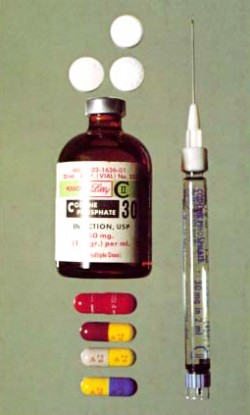As one of the three natural derivatives of opium, codeine carries many of the same addictive properties as morphine and heroin. Codeine’s intended uses as a prescription pain reliever and cough suppressant can be wrought with unexpected consequences when abused on a regular basis.

Codeine, in its many forms, is an addictive drug.
According to Dickinson College, codeine exists as the first opiate derivative to be marketed as an over-the-counter drug. While over-the-counter codeine products do carry a low addiction potential, long-term use greatly increases the risk of addiction.
When taken and abused in prescription form, codeine’s addictive properties come full circle. Regardless of the type of drug involved, codeine’s effects on the brain mark the starting point for how this drug lures users into addiction’s trap.
Codeine Drug Classes
According to the U. S. Drug Enforcement Administration, the federal government assigns certain classifications for drugs known to have a potential for abuse and addiction. As controlled substances, drug classifications run from Schedule I to Schedule V with Schedule I drugs carrying the highest addiction potential.
Codeine comes in prescription form and may also be sold over-the-counter depending on the amount of codeine ingredients. As codeine can be used to treat a wide range of conditions, codeine runs the gamut, spanning from Schedule II to Schedule V drug classes.
Codeine-laced cough syrups make up the bulk of over-the-counter products sold. Prescription medications typically combine codeine with other non-opiate pain relievers as well as with codeine alone.
Codeine Effects in the Brain
Like other opiates, codeine works to relieve pain symptoms by interrupting nerve signal transmissions throughout the brain and central nervous system. The brain also has its own group of endorphin or pain relief chemicals that closely resemble codeine (and other opiates) in chemical structure.
The similarity between codeine and the brain’s natural chemicals accounts for why the brain so readily accommodates codeine’s presence. In effect, the brain can’t tell the difference between codeine and its naturally-occurring chemicals. These conditions make it that much easier for codeine dependence, abuse and addiction to develop.
Abuse Potential
In addition to its pain-relieving properties, codeine can also produce pleasant sensations of euphoria and calm. These effects further enhance the drug’s abuse potential. Codeine also produces a short-acting effect that drives recreational drug users to keep ingesting the drug.
After a while, codeine’s effects on brain chemical processes start to diminish in strength as brain cells become less sensitive to the drug. As a result, users must keep increasing their dosage amounts in order to experience the drug’s “high” effect.
Addition Potential
According to Columbia Health, impaired brain functions, increased tolerance levels and encroaching withdrawal effects all work together to drive a codeine addiction. In effect, a person keeps taking codeine to ward off uncomfortable withdrawal effects, while brain functions deteriorate and tolerance levels continue to rise.
When taken as prescribed, codeine’s addiction potential remains fairly low. When abused, the brain’s physical dependency eventually drives a person to “need” codeine to cope with everyday stressors and pressures. At this point, codeine addiction has come full circle and taken over a person’s priorities and motivations.
